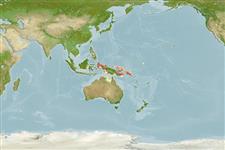Teleostei (teleosts) >
Gobiiformes (Gobies) >
Gobiidae (Gobies) > Gobiinae
Etymology: Tryssogobius: Greek, tryo, tryso = to wear away + see under Gobius; flavolineatus: Name from Latin 'flavus' for yellow and 'lineatus' for line, refers to the most conspicuous colour marking, the yellow line passing from behind the eye to below the first dorsal fin.
More on author: Randall.
Environment: milieu / climate zone / depth range / distribution range
Ecology
Marine; demersal; depth range 28 - 82 m (Ref. 75950). Tropical
Western Pacific: New Guinea and Indonesia.
Size / Weight / Age
Maturity: Lm ? range ? - ? cm
Max length : 2.5 cm SL (female)
Short description
Identification keys | Morphology | Morphometrics
Dorsal spines (total): 7; Dorsal soft rays (total): 10; Anal spines: 1; Anal soft rays: 11; Vertebrae: 26. This species is distinguished by the following characters: D VI + I, 10; A I, 11; pectoral rays 17-19; cheek with 2 rows of scales; eye diameter 2.45-2.7 in HL; interorbital width 4.6-5.65 in HL; first dorsal spine longest in adults, 3.65-4.65 in SL, but second and third spines are nearly as long; rhomboid caudal fin, 2.6-3.5 in SL; pectoral fins 3.4-3.6 in SL; grey with a dark-edged yellow line from behind eye, parallel to dorsal profile of postorbital head and nape, and ending below first dorsal fin; base of dorsal fins with a narrow yellow band; caudal fin with 3 blue-edged yellow stripes; pelvic fins whitish (Ref. 75950).
Inhabits sheltered reefs with silty sand and rubble bottoms in 25-82 m (Ref. 90102).
Life cycle and mating behavior
Maturity | Reproduction | Spawning | Eggs | Fecundity | Larvae
Randall, J.E., 2006. Three new species of the gobiid fish genus Tryssogobius from the western and South Pacific. Aqua, 11(3):105-116. (Ref. 75950)
IUCN Red List Status (Ref. 130435: Version 2024-2)
Threat to humans
Harmless
Human uses
Tools
Special reports
Download XML
Internet sources
Estimates based on models
Preferred temperature (Ref.
123201): 27 - 28.8, mean 27.7 °C (based on 24 cells).
Phylogenetic diversity index (Ref.
82804): PD
50 = 0.5078 [Uniqueness, from 0.5 = low to 2.0 = high].
Bayesian length-weight: a=0.01023 (0.00477 - 0.02194), b=3.01 (2.83 - 3.19), in cm total length, based on LWR estimates for this (Sub)family-body shape (Ref.
93245).
Trophic level (Ref.
69278): 3.1 ±0.3 se; based on size and trophs of closest relatives
Resilience (Ref.
120179): High, minimum population doubling time less than 15 months (Preliminary K or Fecundity.).
Fishing Vulnerability (Ref.
59153): Low vulnerability (10 of 100).
